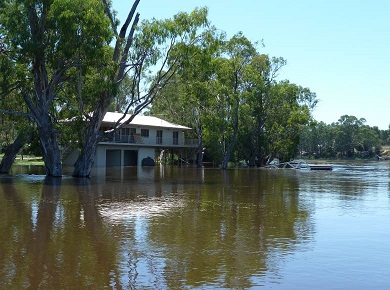
Flood is defined as:
the covering of normally dry land by water:
- that has escaped or been released from the normal confines of:
- any lake, river, creek or other natural water course, whether or not altered or modified;
- any reservoir, canal or dam;
- coastal or marine waters on to land; and
- pipes, dams, levees or other infrastructure due to structural failure, operations, malfunction, accident or other reasons.
- flowing overland:
- towards a watercourse, lake, coast/marine water or other water body;
- and/or from a watercourse or drain that is blocked.
Types of flooding
Different types of flooding have their own characteristics:
Riverine Flooding
Flooding that occurs as a result of rainfall within the catchment of a watercourse such as a river or creek. Riverine flooding is sometimes defined as flooding that takes six hours or more from the time of rainfall for a flood to occur, as opposed to flash flooding which occurs in less than six hours.
Riverine flooding is usually caused by prolonged or severe rainfall in the upper reaches of a catchment. This water then travels through rivers and creeks, causing flooding where the volume of water exceeds the capacity of the riverbed.
Flash Flooding
Flash flooding occurs within six hours of the causative rainfall event. This type of flooding is caused by high rainfall storm events and can occur very quickly at almost any location. Flash flooding can come from creeks with smaller catchments which respond quickly to rainfall, or as the result of intense rainfall causing overland flow and ponding of water. As there is little opportunity to warn people and prepare, flash flooding can be very destructive. This is especially the case as flash flooding can often generate very fast moving water very quickly which can threaten people and property.
Coastal Flooding
Coastal flooding is due to tidal or storm-driven coastal events, including storm surges. This can be exacerbated by wind-wave generation from storm events and king tides. Future sea level rise as a result of climate change may also impact upon coastal flooding in the future.
Infrastructure failure
Infrastructure failure occurs when infrastructure including levees, dams and pipes fail due to lack of maintenance, age, poor operation, climate impacts or extreme circumstances including other natural disasters such as earthquakes.
Return to FAQ's